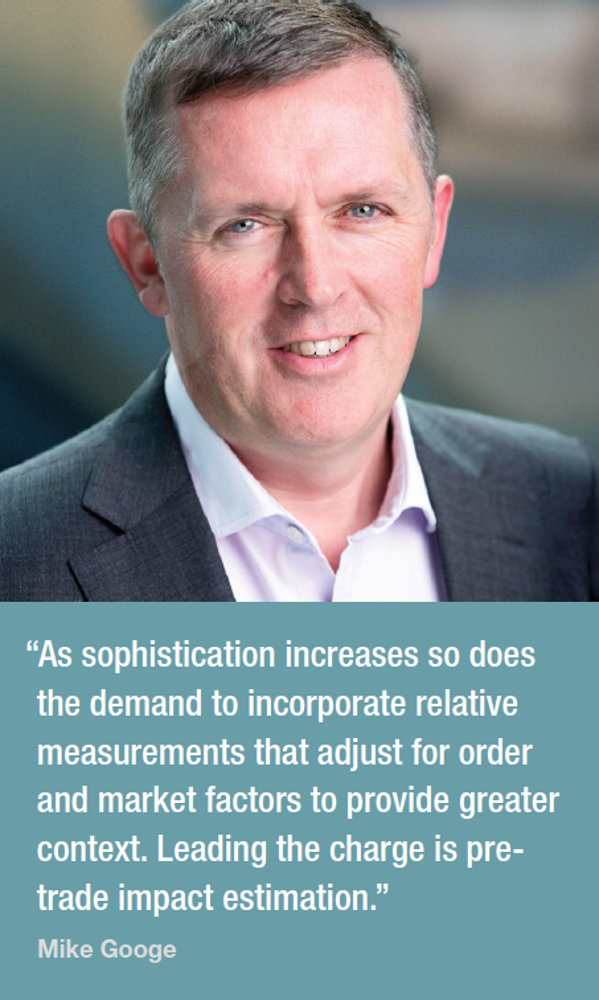Fixed income TCA: The state of the art.
Scratching the surface of buy-side transaction cost analysis use reveals demand for very tailored metrics, as Mike Googe, Product Manager BTCA and Ravi Sawhney, Global Head of Trade Automation & Analytics, at Bloomberg explain to The DESK.
The DESK’s TCA Survey has shown real appetite amongst buy-side traders for applying analytics to bond trading, with traders seeking ever more sophisticated approaches and granular ways to measure their trading activity. Identifying insights and outliers can lead to performance improvements and can accelerate their trading automation goals, all with the objective of gaining that competitive edge
Given the very different investment strategies and instrument profiles of buy-side bond traders, we will look at the methodologies being adopted and how Bloomberg BTCA is positioning itself as a leader in this field.
 Benchmarks: Shifting from absolute to relative measures
Benchmarks: Shifting from absolute to relative measures
The right benchmark is the key component to deliver a meaningful analysis, alongside factors such as order characteristics and market conditions.
Absolute styles of benchmarking, typical during the early stages of fixed income (FI) TCA adoption, are being refined to match order profiles with more appropriate benchmarks. For instance, some traders are using far-touch measures rather than the traditional mid to account for spread capture, reflecting the nuances of liquidity in FI markets. The use of axes as a means to benchmark has grown for the same reason.
As sophistication increases so does the demand to incorporate relative measurements that adjust for order and market factors to provide greater context. Leading the charge is pre-trade impact estimation. As observable post-trade results have increased in line with post-trade TCA adoption, a wealth of data has been unlocked to model predictions of implementation cost and probability of execution.
Based on correlation models, predictions provide the benefit of following a scaling that is sensitive to order size and market conditions. Estimates can provide traders and portfolio managers with a frame of reference for likely execution cost, allowing expectations to be set up-front and in post-trade to adjust absolute arrival price. This allows users to distil a relatively positive outcome even when the absolute measure shows slippage.
Capturing the spread to the default benchmark at order arrival shows the absolute arrival price for the target bond, and also provides a measure of its value to what is effectively an index of one security at that time. Taking the spread measurement at the time of execution shows how the spread changed in the intervening period. If the order is to buy in a rising market, absolute measures will deliver a negative result but if the target bond tracked or potentially lagged the benchmark, it’s possible to show the spread target was beaten or exceeded despite this absolute result.
Peer benchmarks are also a key tool for FI TCA relative measurement. Calculated using anonymised and aggregated post-trade results of a community, they allow traders to compare the absolute results for their orders with the average performance of peer orders using similar grouping characteristics. This is therefore a comparison of order peers, competing for the same liquidity, rather than an arbitrary comparison of similar firms, and provides another relative measurement. Whilst enforcing minimum contribution thresholds can provide some measure of quality, the next step would be to introduce quantitative measurement of sample density to provide transparency on the quality of the number. Beyond that, studying the distribution tails can also inform traders where to set thresholds for outliers that can show orders executing in the top or bottom segment of all trading.
 Weaving TCA results into the execution workflow
Weaving TCA results into the execution workflow
A striking result of the research in this issue of the The DESK magazine is that 60% of traders thought TCA was effective at improving execution performance, but only 37% of them were applying it in the trading workflow. Whilst TCA has historically been the domain of periodic reports that can be analysed at length, the utility of that approach is limited. Time pressure to make effective trading decisions requires that the output of TCA needs to be weaved into the trading lifecycle.
For decision support, the current push is to incorporate post-trade insights as part of the pre-trade workflow, answering questions like ‘who is my most active/best performing/consistent dealer for orders like this?’ within the execution management system (EMS). This helps traders decide which dealers to route their RFQ’s to, or how best to manage orders according to time of day. Providing the context of the order in hand to deliver these insights and execution quality monitoring in real-time within the trading ecosystem is quickly putting the traditional TCA report into the role of supporting periodic reviews and customer recap reports.
Exception-based monitoring is increasingly used to shift outlier detection to proactive alerts from reviewing reports. Articulating a user’s rules on acceptable execution quality, based on the principles described above, where firms can set distinct thresholds against a benchmark(s), allows for proactive monitoring. Utilising a peer group also allows users to gain a frame of reference for setting meaningful tolerances and avoids trial and error.
Using BTCA can also shed light on automated execution through its integration with Bloomberg Rule Builder, which facilitates trade automation. It can assess relative performance of human versus automated flow and drill down to look at performance by individual automation rules against given benchmarks. Teasing out insights from this will ultimately help desks optimise and expand their automation capabilities.
The next frontier is analysing in-house data. Firms want to consume machine-readable data electronically via API to nourish their own reporting tools, blended with proprietary data to drive their own decision support and reporting tools, as well as to conduct their own quant study. One approach is to make a client’s data available in Bloomberg’s BQL/BQNT platform, which will allow users to draw from multiple Bloomberg data sets to generate novel insights faster. For instance, combining TCA data with position data to understand trading costs as a factor of AUM to illustrate to investors the impact of trading on alpha capture.
The next step forward for pre-trade decision support
There is increased demand for the technology itself to conduct the analysis and propose insights, replacing manual rules setting. For example, post-trade users can measure performance in aggregate or account against an array of pre arrival and post last fill time slices to build a momentum picture, which helps traders understand the optimal aggression level of their trading strategy. Understanding these profiles requires a multi-dimensional approach, incorporating other factors, and requires the machine to interpret the results and ultimately make recommendations.
Bloomberg recently expanded its coverage from equities into fixed income by developing a predictive cost model from millions of trades over five years, using features of both the security and the order itself. This model will soon be integrated in BTCA to assess trading performance in a new and powerful way across various bond sub-groups over a time frame.
As pre-trade insights evolve expect a matching shift in workflow. Traders want to increase the use of alerts and predictions that can recommend better courses of action against their intentions. Whilst these signals can be consumed on-screen, they will also drive up automation rates across the desk, allowing traders to re-direct their finite bandwidth to more value-added tasks for their firm.
TCA will be an inherent part of bond trading automation, creating significant performance enhancement for traders and the investors for whom they work.
Fixed income trading analytics have come a long way since emerging a few years ago and traders are now forcing the pace of evolution. Gaining competitive advantage through more precise and refined benchmarks, incorporating broader context to display the perspective gained from relative measures and incorporating these outputs into the trading workflow are stimulating real innovation.
©Markets Media Europe 2025























